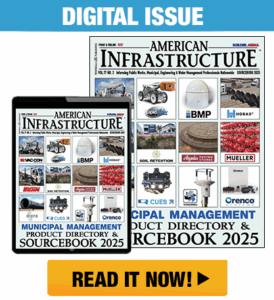
With more funds on the way and confidence levels high, local infrastructure momentum is expected to be sustained
By James Brooks
With a high level of confidence, we can predict that the infrastructure investment environment at the local level in 2024 will be much like it has been in 2023. Inflation has abated from a monthly high of 9.1% in June 2022 to below 3.2% today, and supply chains are more flexible. Despite higher interest rates on bond financing, federal investment dollars are flowing predictably and steadily to states and localities. Municipalities are applying for and winning discretionary grants, or if failing to win, absorbing the debriefing details from federal agencies and trying again. Local capacity is on the rise with support from programs such as the Local Infrastructure Hub, which has helped nearly 700 small and mid-size municipalities apply directly for federal funding, and the Biden administration’s efforts like the Investing in America initiative (build.gov).
In order to track grant awards at the municipal level, the National League of Cities launched the Rebuilding America Dashboard showing that municipalities have been directly awarded more than $13 billion dollars from the Bipartisan Infrastructure Law (BIL). In just two years of BIL, these funds have resulted in more than 1,600 projects focused on resiliency, safety, clean energy, roads, bridges and public transportation across 1,100 municipal governments. Over the next year, more projects will be added to this already impressive dashboard list.
The cascading benefits resulting from local infrastructure investment are being seen in the labor market as well. The BIL is expected to expand the job market by nearly three million jobs each year over the next decade. Although NLC’s research shows that hiring for jobs in the infrastructure sector remains a challenge, expanded workforce development efforts are underway and poised to make a significant difference
In just two years of BIL, these funds have resulted in more than 1,600 projects focused on resiliency, safety, clean energy, roads, bridges and public transportation across 1,100 municipal governments. Over the next year, more projects will be added to this already impressive dashboard list.”
One of the ways NLC is actively engaged in workforce readiness is through the Good Jobs, Great Cities program in partnership with the U.S. Department of Labor. This cohort-based effort works with 16 city teams over two years to create innovative and scalable solutions that train the labor force for high-demand jobs in infrastructure, clean energy and advanced manufacturing.
The City of Fort Lauderdale, Florida is one of these 16 cities with “infrastructure and resilience” as a top priority. The city is making historic investments to address infrastructure needs related to water, wastewater, stormwater and resilience to extreme weather and sea level rise.
Many of these new jobs will be in the green economy supporting the electrification of mobility. To grow the workforce in this sector, NLC is partnering with the Siemens Foundation and the National Governors Association (NGA) to carry out the State and Local Collaborative to Support an Inclusive Workforce for the Electric Vehicle Charging Sector (EV Workforce Collaborative). The EV Workforce Collaborative will provide resources, technical assistance and best practices for state and municipal governments to align policies and funding priorities in the electric mobility sector. Over the next three years of this collaboration, NLC and NGA will facilitate information sharing, promote stakeholder coordination and support training programs for all individuals. Both workforce efforts will focus on supporting residents from historically underserved and underrepresented communities to bolster economic mobility.
Building on the experience of the last two years, cities, towns and villages are accelerating their programs to repair, maintain and replace infrastructure assets that are essential to the quality of life in our nation’s communities. They are also incorporating resiliency and equity principles that will serve their residents over the decades to come. We at NLC are excited to continue assisting municipalities in their infrastructure journeys in 2024 and beyond.
James Brooks is the director of Infrastructure Solutions in the Center for Municipal Practice at the National League of Cities.















